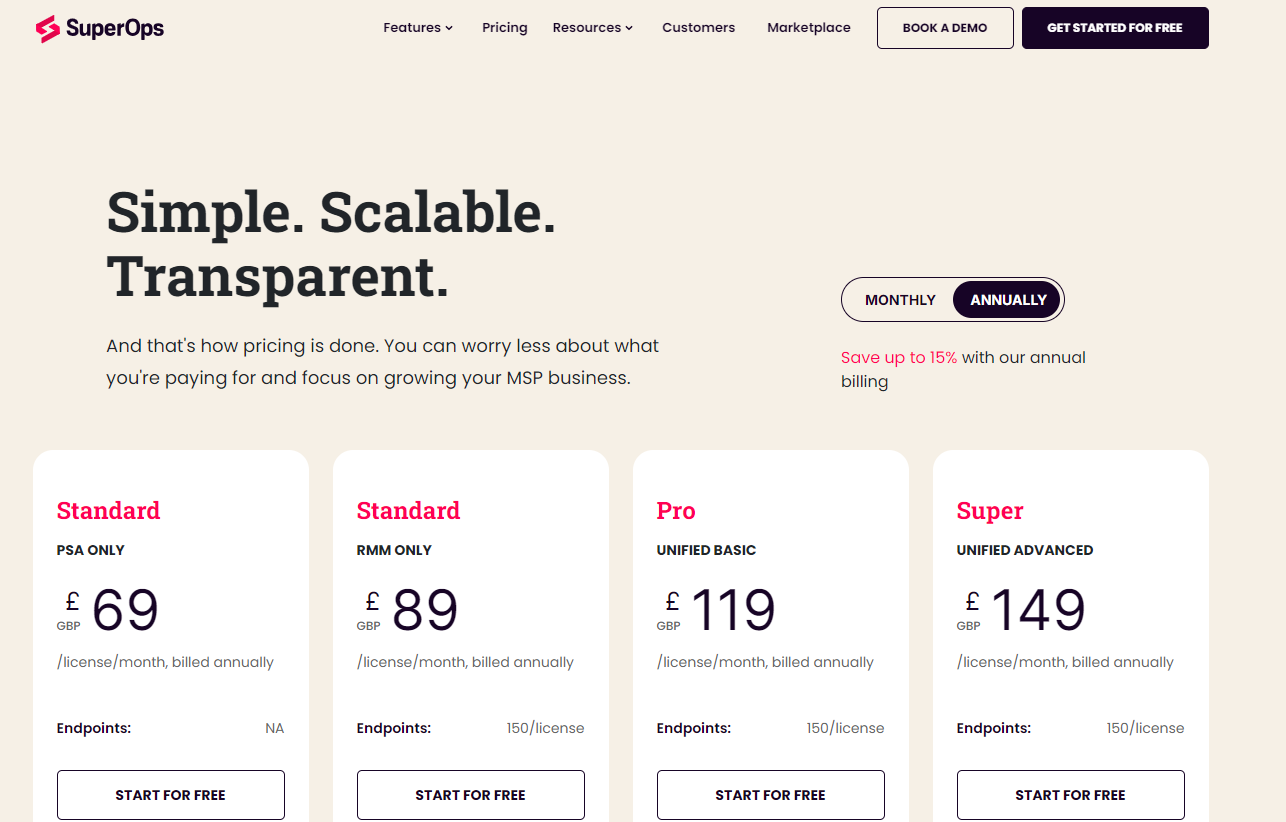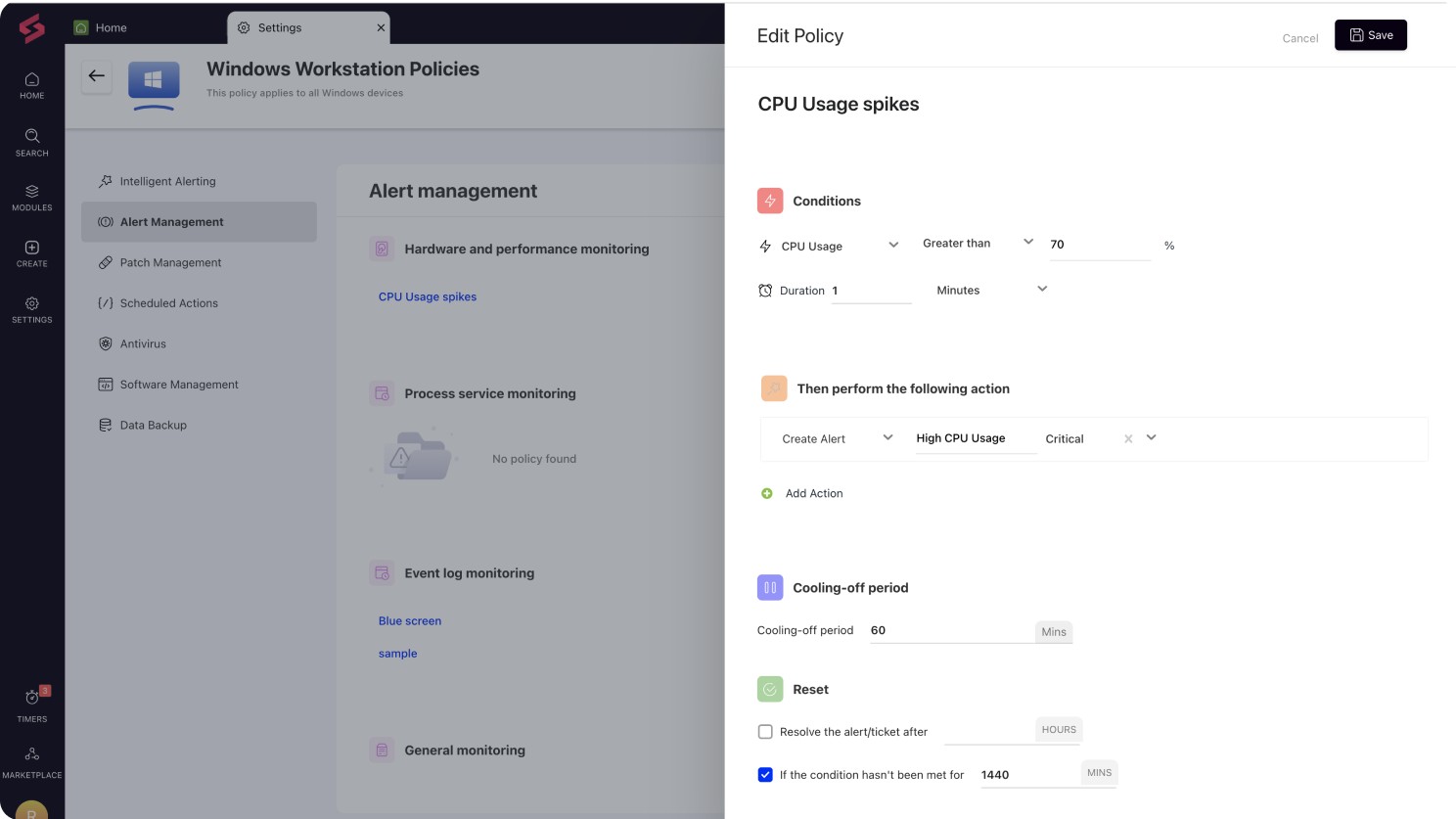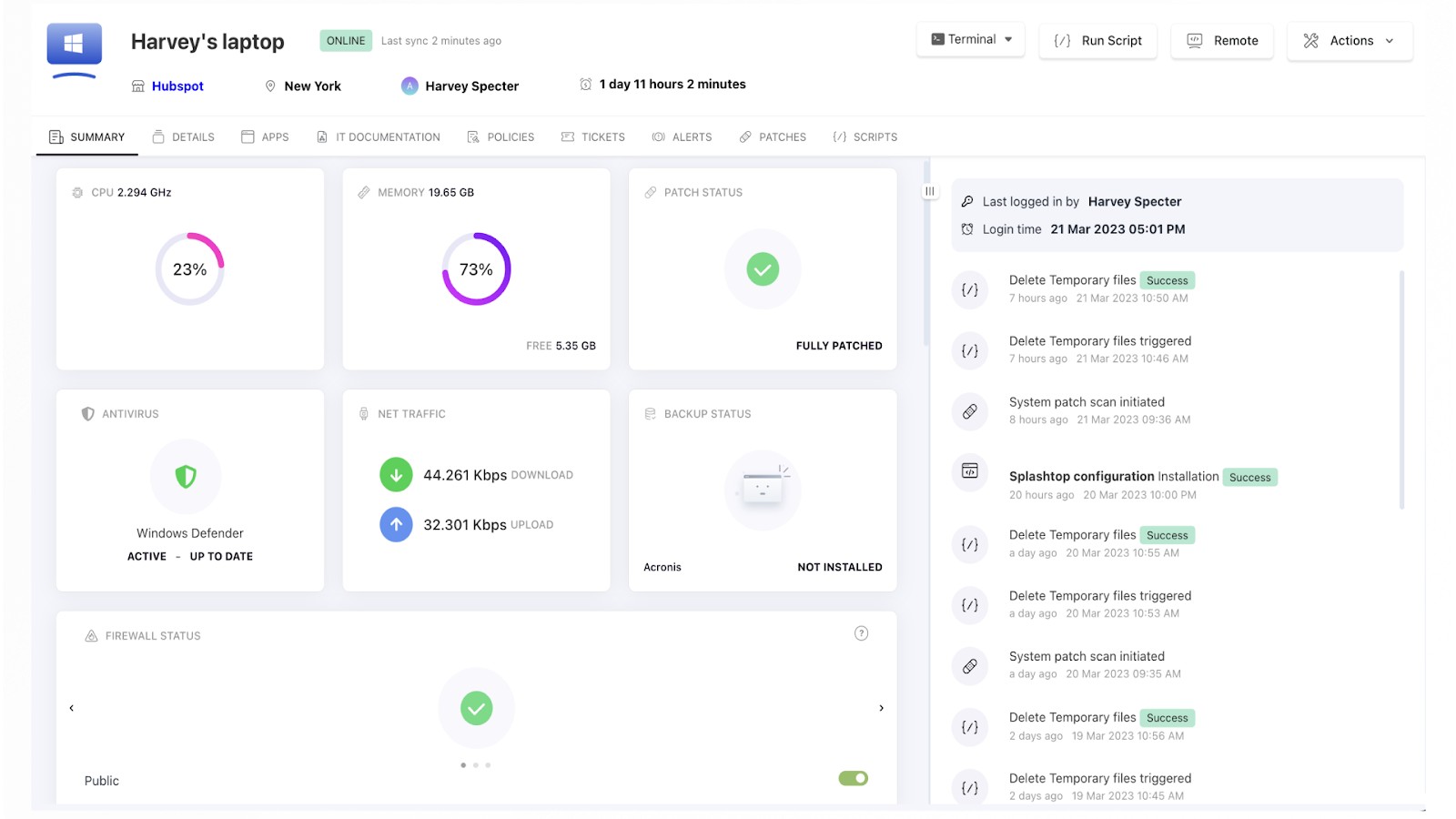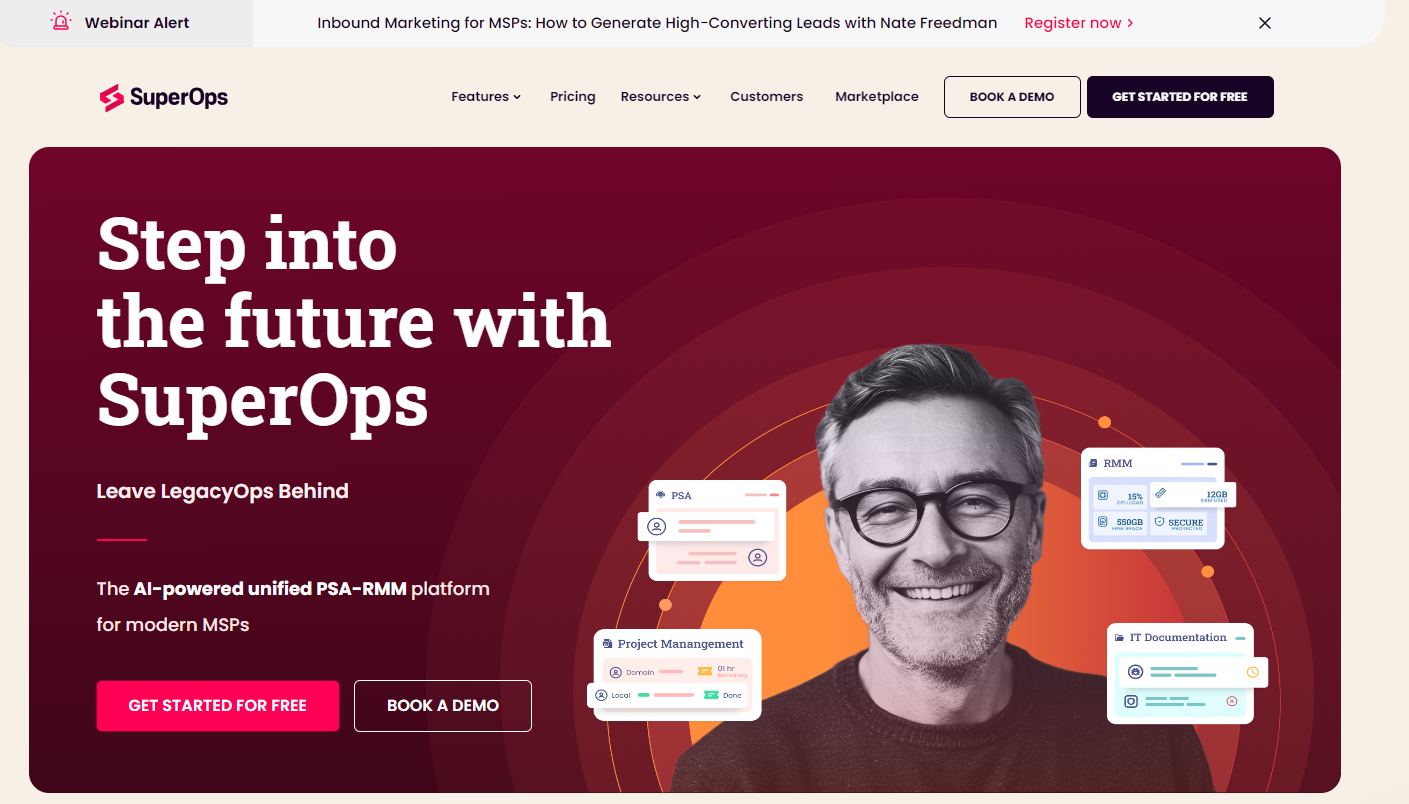TechRadar Verdict
SuperOps is a multi-dimensional PSA and RMM platform that allows you to manage all your assets at a cost of less than $0.66/endpoint/month. The platform is the best in the industry when it comes to setting up automation and alerts. Plus, its newly incorporated Intelligent Alerting system boots productivity and cuts down on redundant tasks.
Pros
- +
Intelligent AI-based alerting system
- +
It's a multi-dimensional tool with PSA and project management
- +
Highly affordable, as it costs less than $1/endpoint
- +
Easy automation options with custom scripts
Cons
- -
It can be expensive for startups with less than 30 endpoints
Why you can trust TechRadar
SuperOps is a diverse RMM and PSA tool that allows businesses and MSPs to manage endpoints, patch them, and also solve ticketing queries. It comes with several project management tools that help you streamline day-to-day work, and it has also recently introduced network monitoring and IT documentation functions.
Founded in 2020, SuperOps is relatively new in the industry. However, it has quickly caught everyone’s eye, owing to its unique technician-based pricing and intelligent AI alerting features. It's also quite easy to set up and has won 17 awards at the recently concluded G2’s Winter 2023 announcement, including badges such as Best Support (small business), High Performer, and Easiest Setup.
In this in-depth SuperOps review, we'll discuss some of its best features, support options, ease of use, security, and, of course, its value for money.
SuperOps: Plans and pricing

What we liked the most about SuperOps’ pricing is that there’s a plan for distinct needs – PSA and RMM. So, if you only need RMM functions, you can choose the Standard plan at $99/license/month. On the other hand, if you only need PSA functions, you can choose to pay for just that: $79/license/month.
Each license covers 150 endpoints. So, the RMM cost boils down to $0.66/endpoint/month, which is very affordable, making it ideal for large teams with lots of endpoints. Plus, if you have more than 150 endpoints, you can buy an additional endpoints pack at $75 for 150 endpoints per month.
However, if you’re a small business and have only 20-30 systems, you’d still have to pay $99/month, since there’s no option to add an individual endpoint – you have to purchase the entire lot. So, SuperOps can quickly become expensive for startups and small businesses.
If you’re looking for both PSA and RMM functions, you can get SuperOps’ Pro or Super plan, costing $129/license/month and $159/license/month, respectively.
Sign up to the TechRadar Pro newsletter to get all the top news, opinion, features and guidance your business needs to succeed!
Even better, there’s also a 14-day free trial, which will allow you to test the tool's various features risk-free before committing.
SuperOps: Features
We'll now discuss the most notable SuperOps features.
Automation
One of the best features of SuperOps is the degree of automation you get with its policy management functions. This lets you set up policies that help you define a framework to monitor all the assets you manage. There are two types of policies: hierarchal and group-based.
A hierarchal policy allows you to create a policy set for an asset on the global level, which can be overridden at a client, site, or device level. You can configure both alerts and patch management for Windows and Mac assets.
Alerts
SuperOps lets you set up rule-based alerts for events on the client’s device and even configure auto-remediation actions. For example, you can create an alert when the free disk space on a device goes below a specific level.

What's more, you can also define the action that needs to be taken: deleting temp files, creating a ticket, or sending an email to a technician. Similarly, you can automate patch management by pre-defining approval configurations and deployment schedules with various conditions.
Schedule actions
We also liked the scheduled actions feature under SuperOps’ policy management. You can schedule scripts to be executed at specific times (once a day, week, or month). While SuperOps offers a handful of default scripts, you can also build a custom script from scratch, either for all your clients, a specific client, or even a particular asset.
Antivirus integrations
Taking security a notch higher, SuperOps lets you connect antivirus solutions with the platform. Currently, there are four antivirus integrations available: Webroot, Bitdefender, SentinelOne, and Emsisoft.
Once you’ve successfully integrated the two platforms, you can create a policy to manage the antivirus software on the device. Each alert from the antivirus gets created as a ticket so that no security issues fall through the cracks.
Intelligent Alerting
Another feature that deserves special mention is Intelligent Alerting, which is an AI-powered alert mechanism that increases technicians’ efficiency and productivity. When toggled on, Intelligent Alerting deeply understands your client’s device – behaviors, schedules, and routines.
It then builds patterns and identifies deviations from these patterns. These deviations or anomalies are then flagged as threats, based on their severity and priority. Intelligent Alerting goes a step ahead of traditional alert management.
Here, you do not need to set up any conditions or criteria. All you have to do is toggle a button and choose the category where you want to enable AI alerts: CPU usage, memory usage, or disk usage. However, a caveat is that the system can take up to 25 days to fully analyze the target system and produce accurate alerts.
SuperOps: Interface and performance
SuperOps features a relatively clean, modern, and customizable home screen. It gives you a snapshot of various performance metrics, such as open alerts, patches, tickets due today, and all pending approvals.
We also liked the ‘mentions’ widget, which lets you know if any client or team member has mentioned you in a ticket or internal note.

The best part is that these widgets are completely customizable, and you can view the widget library from the top-right corner of the home screen and choose widgets that are of utmost importance to your role.
Since SuperOps is a multi-dimensional tool, there’s a separate ‘Modules’ tab on a sleek left panel. From here, you can select the function you want to work on: Asset management, client management, tickets, tasks, or projects.
Overall, it can admittedly take a bit of time to get a hang of SuperOps’ interface, especially if you haven’t worked with RMM software before. However, once you learn the ropes, the platform is fairly easy to use.
SuperOps: Security
SuperOps complies with SOC II Type 2, HIPAA, and GDPR to ensure that sensitive business data is handled as per set regulations.
Plus, the platform is hosted on a dedicated Virtual Private Cloud (VPC) on Amazon Web Services (AWS), which complies with several assurance programs, such as SOC 1/ISAE 3402, SOC 2, SOC 3, PCI DSS Level 1, FISMA, and DIACAP.
Furthermore, all the data on the website is secured in private subnets and virtual firewalls that allow only pre-established transactions. Plus, SuperOps uses industry-standard AES 256-bit encryption to secure your data.
There are also a lot of security control options you get as a user. For instance, you can enable two-factor authentication to prevent unauthorized access. You can also set up role-based access rules to ensure users can access only those parts of SuperOps that are necessary for their respective functions.
SuperOps: Support
SuperOps has a very detailed ‘Help Center’ page with numerous articles on various topics, such as client management, policy management, automation, reporting, etc. You’ll also see a live chat option at the bottom of your screen, where you can connect to a human representative instead of a bot – super handy since live chat is often the most effective port of call for troubled users.
There are also a lot of blogs, pre-recorded webinars, guides, community hubs, and podcasts, which give you a comprehensive insight into SuperOps’ functions.
Moreover, in the unlikely event that you do not find a solution to your queries, you can reach out to the customer support team through a phone call or email address. The customer service team is responsive and will promptly resolve any queries you might have.
SuperOps: Final verdict
SuperOps is an excellent RMM software with extensive automation capabilities at just $0.66/endpoint/month, making it one of the most affordable options out there, especially for medium-sized and large businesses with lots of endpoints.
Its Intelligent Alerting feature sets it apart from the rest. This feature learns the behavior of the endpoints and sends alerts if it finds any deviation from patterned behaviors, saving a lot of time for technicians. You can also automate patch management, build custom alerts, and set up hierarchical and group policies for asset management.
If you’re looking for a multi-dimensional tool that goes beyond RMM, SuperOps is a perfect pick. You get a dedicated PSA module, where you can manage service tickets, invoicing, quotes, and even manage your ongoing projects. Alternatively, if you want both RMM and PSA features, there are specific plans for that too.
That said, SuperOps can be expensive for startups and small businesses with less than 30 endpoints due to its step-up pricing module – but you can leverage its 14-day risk-free trial to test it out for yourself.
SuperOps: FAQs
How much does SuperOps cost?
SuperOps offers dedicated plans for PSA and RMM functions, costing $79 and $99/license/month, respectively. You can manage up to 150 endpoints with each license and even purchase an additional 150 endpoints for $75/month. If you need both PSA and RMM functions, you can go for its Pro or Super plan, costing $129 and $159/license/month, respectively.
For what purposes can I use SuperOps?
SuperOps is a multi-dimensional business tool that supports various functions such as remote asset management, project management, PSA services, and IT documentation. We liked the platform’s extensive automation function, using which you can streamline functions such as patching, ticketing, scheduling, and more.
Krishi covers buying guides and how-to's related to software, online tools, and tech products here at TechRadar. Over at Tom's Guide, he writes exclusively on VPN services. You can also find his work on Techopedia and The Tech Report. As a tech fanatic, Krishi also loves writing about the latest happenings in the world of cybersecurity, AI, and software.
